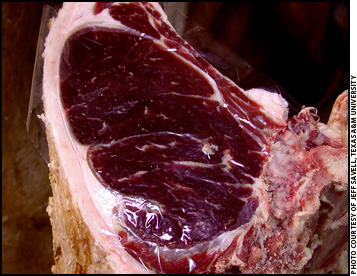Calm Down, Lighten Up
Cattlemen can help prevent dark cutters.

As an animal is harvested its body draws on stored reserves of energy (sugar) to create lactic acid in the muscles, David O'Diam explains. That slight decline in alkalinity (decrease in pH) sets up the meat to react with oxygen to show the bright, cherry-red color beef consumers are accustomed to.
Excited cattle can become "dark cutters," lowering profit potential and causing beef demand challenges, says David O'Diam, brand extension manager for Certified Angus Beef LLC (CAB).
As an animal is harvested its body draws on stored reserves of energy (sugar) to create lactic acid in the muscles, he explains. That slight decline in alkalinity (decrease in pH) sets up the meat to react with oxygen to show the bright, cherry-red color to which beef consumers are accustomed.
But stress prior to harvest depletes the energy reserve. Without time to recharge, meat from the animal will be unable to form enough lactic acid to decrease the pH level. The sustained higher pH level allows meat to hold more water, O'Diam says.
"It's like cardboard," he says. "As it gets wet it turns a different, darker color." Hence, it becomes a dark cutter and that makes it ineligible for the Certified Angus Beef ® (CAB®) brand.
The causes of a dark cutter depend as much on the animal as on the conditions surrounding it.
"Different people react to different things, and it's the same with cattle," O'Diam says.
"Animals that are timid or afraid tend to stress more easily," says Jeff Savell, animal scientist at Texas A&M University.
The incidence of dark cutters averages about 1%, so it can be difficult to make measureable change as an industry, O'Diam says. However, producers can employ strategies to lower the risk, especially if their cattle have greater-than-average issues.
Animals should be healthy, well cared for and handled as calmly as possible, says Phil Bass, a meat scientist and executive account manager for CAB.
"Make sure they have plenty of feed and water a couple of days before they are shipped to increase the sugar stores in their muscles," he says. "You can take preventive measures and select for calmer animals, too."
The Angus breed offers a selection tool in the form of an expected progeny difference (EPD) rating for docility. Including that EPD in selection can help reduce the incidence of dark cutters, Bass says.
Data from the Iowa Tri-County Steer Carcass Futurity indicate that calm cattle returned $39.01 more per head than aggressive herd mates. The rate of CAB brand acceptance more than doubled for the docile group, earning them more carcass premiums.
On the other hand, discounts for dark-cutting carcasses can amount to $30 per hundredweight because consumers are unwilling to purchase the off-color meat. Stores rarely place it on the counter, O'Diam says.
Produces can influence handling, feeding and breeding, but there is at least one stressor they have no control over.
 "Weather changes can frequently account for increases in dark cutters," Savell says. "In Texas, we see more dark cutters in October because of the weather."
"Weather changes can frequently account for increases in dark cutters," Savell says. "In Texas, we see more dark cutters in October because of the weather." Dark cutters are hard to avoid altogether, he says: "There is no sure-fire method for preventing them."
Still, it makes sense to focus on what can be controlled. "As producers work to improve on this, the same management should help ensure higher quality grades and a better end product," Savell concludes.
That leads to improved consumer demand, something worth getting excited about.




